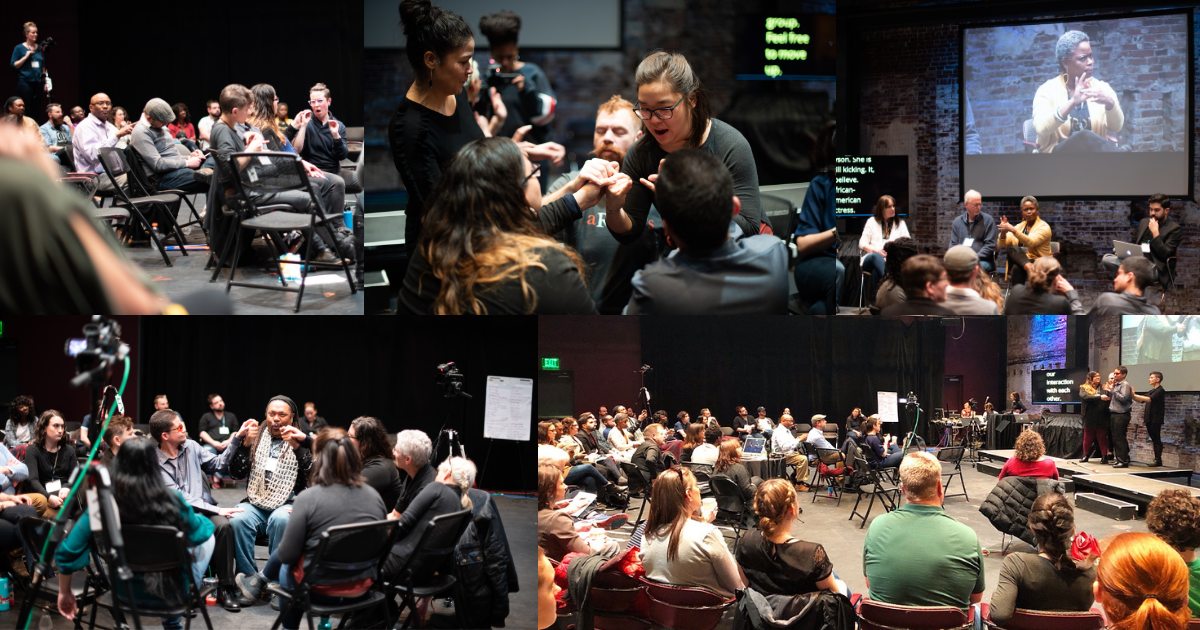Deaf Theatre Action Planning Session
Watch the full video from the convening here
Boston, Massachusetts, 15-17 March 2019
The Deaf Theatre Action Planning Session convening, hosted by HowlRound in partnership with Tyrone Giordano, DJ Kurs, Patty Liang, Alexandria Wailes, Ethan Sinnott, and Rachel Grossman, gathered thirty Deaf theatre producers and administrators from across the country, with the intention to develop a future-focused, action-oriented plan for creating a national network and training-to-production "pipelines" that foster the long-term education and advancement of all Deaf theatre artists.
This event is one of four convenings selected as part of the HowlRound Challenge to advance the role of the arts as a catalyst for social change. The HowlRound Challenge and this convening are made possible thanks to the support of the Barr Foundation.
All events, unless otherwise noted, took place at the Jackie Liebergott Black Box in the Paramount Theatre, located at 559 Washington Street, Boston, MA 02116.
Convening Participants
You can read more about the participants here.
Bellamie Bachleda (Deaf Austin Theatre), Michelle A. Banks, Fred Michael Beam, Sarah Bowden, Jill Marie Bradbury, James Caverly, Chase Chambers, Brian Andrew Cheslik (Deaf Austin Theatre), Aimee Chou, Richard Costes, Jules Dameron, Sabina England, Kalen Feeney, Tyrone Giordano, Kala Granger, Rachel Grossman, JW Guido (New York Deaf Theatre), Amelia Hensley, Monique Holt, EJ Joseph, Aaron W. Kelstone (RIT/NTID), David Kurs, Patty Liang, Andrew Morrill, Jasper Norman (ProTactile Theatre), Natasha Ofili, Mervin Primeaux-O'Bryant, Deborah Reed (Deaf West Theatre), Yash Romilus (ProTactile Theatre), Nicki Runge (ImaginASL), Ryan Schlecht, Robert Sirvage, Ethan Sinnott, Shanna Sorrells, Alexandria Wailes, Annie Wiegand
“In the world of theatre, often people only see the Deaf identity on the stage—ASL, ASL, everything is about ASL……. And I say, where are the other communities that need to be clearly represented on stage? We have to get out of our bubbles. That includes the Deaf community, which also needs to learn about our intersectional identities.” — Fred Michael Beam
The convening began by asking for bright spots by prompting participants to discuss successes they are witnessing throughout the country in Deaf and DeafBlind theatre, and then moved into deep conversations around questions like:
- Where are the gaps in Deaf theatre and where is there room to strengthen and build internally?
- What needs to happen in terms of skill and knowledge transfer across generations?
- Is Deaf theatre still valued by the Deaf communities as it was for much of the twentieth century?
- What does a fully inclusive theatre feel like?
Read the convening report by Jill Bradbury

“How can we change things for people of color who are Deaf performers, Deaf artists? We need to focus on making a space for people where they can be welcomed for sharing their talent.” — Natasha Ofili
Participants broke out into groups to brainstorm action plans for the future of Deaf theatre over the following three months, five years, and fifty years. Groups then shared their top ideas for each time frame. Potential three-month projects included establishing a database of performers, writers, directors, and designers; maintaining ongoing discussions on Facebook or other social media platforms; and establishing a network of regional advocacy groups. Suggested five-year projects included creating professional-development workshops on a wide variety of topics; starting a foundation or funding pool to support access for Deaf and DeafBlind theatremakers; building toolkits for theatre artists and educators of Deaf children; running more events like the convening to produce tangible results; and producing two or three Broadway productions featuring Deaf theatre artists. Fifty years in the future, participants hoped to see an annual Deaf and DeafBlind festival fully inclusive of all theatrical approaches and communal theatrical spaces accessible for DeafBlind individuals throughout the various regions of the United States and abroad.
Read related HowlRound content
“What we have attempted to achieve this past weekend represents an unprecedented, revolutionary shift, one that is nascent. Please be mindful of the inevitability of mistakes and the occasional stumble made along the way, but the absolute worst thing to do would be to give up, because we may, in the future, look back at this weekend as a seminal moment for American Deaf theatre moving forward.” — Ethan Sinnott
